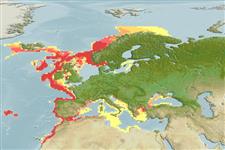Environment: milieu / climate zone / depth range / distribution range
Ecology
Marine; bathydemersal; depth range 100 - 700 m (Ref. 56504). Deep-water; 73°N - 26°N, 30°W - 37°E (Ref. 54564)
Northeast Atlantic: Iceland southward to Cape Bojador (26°N), West Sahara and in the western Mediterranean.
Length at first maturity / Size / Weight / Age
Maturity: Lm 25.8 range ? - ? cm
Max length : 60.0 cm TL male/unsexed; (Ref. 3397); common length : 25.0 cm TL male/unsexed; (Ref. 3397); max. published weight: 0.00 g; max. reported age: 16 years (Ref. 108908)
Dorsal spines (total): 0; Dorsal soft rays (total): 85 - 94; Anal soft rays: 64 - 74. Dorsal fin origin closer to tip of snout than to anterior edge of eye. Dorsal and anal fins terminate just a little on the blind side of the caudal peduncle. Lateral line forms a distinct curve above the pectoral fin. Dorsal and anal fin with indefinite darker spots posteriorly.
Adults occur on soft bottoms. Depth range from 100-400 m (Ref. 06302) and from 288-700 m in the eastern Ionian Sea (Ref. 56504). Feed on small bottom-living fishes as well as squids and crustaceans (Ref. 4703). Spawning occurs in deep waters off Iceland and west of the British Isles (Ref. 35388).
Nielsen, J.G., 1990. Scophthalmidae. p. 1026. In J.C. Quero, J.C. Hureau, C. Karrer, A. Post and L. Saldanha (eds.) Check-list of the fishes of the eastern tropical Atlantic (CLOFETA). JNICT, Lisbon; SEI, Paris; and UNESCO, Paris. Vol. 2. (Ref. 6501)
IUCN Red List Status (Ref. 130435)
Threat to humans
Harmless
Human uses
Fisheries: highly commercial
Tools
Special reports
Download XML
Internet sources
Estimates based on models
Preferred temperature (Ref.
123201): 6.3 - 11.4, mean 7.7 °C (based on 165 cells).
Phylogenetic diversity index (Ref.
82804): PD
50 = 0.7520 [Uniqueness, from 0.5 = low to 2.0 = high].
Bayesian length-weight: a=0.00479 (0.00375 - 0.00610), b=3.10 (3.03 - 3.17), in cm total length, based on LWR estimates for this species (Ref.
93245).
Trophic level (Ref.
69278): 4.3 ±0.1 se; based on diet studies.
Generation time: 6.5 (5.5 - 9.2) years. Estimated as median ln(3)/K based on 23
growth studies.
Resilience (Ref.
120179): Medium, minimum population doubling time 1.4 - 4.4 years (K=0.13; tm=2-4; Fec = 26,522; tmax=16).
Prior r = 0.41, 95% CL = 0.27 - 0.62, Based on 9 full stock assessments.
Fishing Vulnerability (Ref.
59153): High vulnerability (60 of 100).
Climate Vulnerability (Ref.
125649): Low vulnerability (25 of 100).
Nutrients (Ref.
124155): Calcium = 21.2 [10.9, 41.1] mg/100g; Iron = 0.309 [0.126, 0.732] mg/100g; Protein = 19.3 [17.5, 20.9] %; Omega3 = 0.35 [0.17, 0.77] g/100g; Selenium = 14.6 [4.4, 46.1] μg/100g; VitaminA = 12.1 [2.5, 55.2] μg/100g; Zinc = 0.285 [0.146, 0.582] mg/100g (wet weight); based on
nutrient studies.
